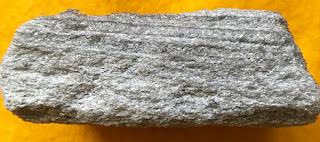Tessarolax is one of the most "eye-catching" examples. It is an extinct genus characterized by having four long digitations, used to support its shell on soft ocean-floor sediments. The above images are of three different species at oblique views. The specimens range from 70 to 120 mm (max. dimensions). Tessarolax belongs to family Aporrhaidae (pronounced "a-poor-rye-id-dee"). Tessarolax, which is only of Cretaceous age, was widespread in the world.
These two images of Tessarolax are of two different species showing how their shells relate to the ocean floor (substrate). Both specimens are approximately 50 mm, from left to right. Very careful collecting and cleaning are required in order to obtain such high-quality specimens. For the latest information on Tessarolax and also on the details about the species represented by the above-illustrated specimens, see the reference:
Saul, L.R. and R.L. Squires. 2015. Pacific slope of North America record of the Cretaceous aporrhaid gastropod Tessarolax: Evolutionary trends, mode of life, and paleobiogeography of the genus. Contributions in Science v. 523, pp. 37–65. (pdf available for free---just "Google" the title of the paper.
Anchura is another example of an aporrhaid gastropod having an extension of its shell in order to provide stability on the ocean floor.
For more information on Anchura, see the reference:
Elder, W.P. and L.R. Saul. 1996. Taxonomy and biostratigraphy of Coniacian thorugh Maastrichtian Anchura (Gastropoda: Aporrhaidae) of the North American Pacific slope. Journal of Paleontology 70(3):381–399. (pdf available for free---just "Google" the title of the article).
These two specimens of the gastropod Xenophora look like two small stacks of pebbles. This genus, which is extant, is known as colloquially as the "carrier shell" because it collects and carries pebbles and/or other shells (by cementing them onto its own shell), in order to provide protection/camouflage for itself. In essence, it was the first fossil collector. For more information on this fossil Xenophora, see the reference:
Squires, R.L. and L.R. Saul. 2001. New Late Cretaceous gastropod from the Pacific slope of North America. Journal of Paleontology 75(1):46–65. (pdf available for free---just "Google" the title of the article).
This specimen (height 50 mm) belongs to genus Paosia, formerly known by its junior synonym name of Trajanella. Paosia has a long geologic time range of 75 million years. It is mainly known from Europe, but a lineage became established along the Pacific coast of North America for 25 million years. For more information, see the reference:
Squires, R.L. and L.R. Saul. 2004. The pseudomelaniid gastropod Paosia from the marine Cretaceous of the Pacific slope of North America and a review of the age and paleobiogeography of the genus. Journal of Paleontology 78(3):484–500.
Alamirifica corona genus and species Saul and Squires, 2003; two views, front and back (height 37 mm). Late Cretaceous (Turonian), southern California. This specimen is exceptional because it shows all the exquisite details of its aperture. For more information about this species, see the reference:
Saul, L.R. and R.L. Squires, 2003, New Cretaceous cerithiform gastropods from the Pacific slope of North America. Journal of Paleontology 77(1):442–453.
Pentzia hilgardi (White, 1889); two views, front and back (height about 10 mm). Late Cretaceous (Campanian to early Maastrichtian). Genus Pentzia consists of only a single species, which is found only in Washington, California, and northern Baja California (Mexico). This species has an usually long geologic time range, which is approximately 13 million years. Most gastropod species last for much shorter time intervals. For more information about this genus and species, see the reference:
Squires, R.L and L.R. Saul, 2003, New Late Cretaceous (Campanian and Maastrichtian) marine gastropods from California. Journal of Paleontology 77(1):50–63.



























